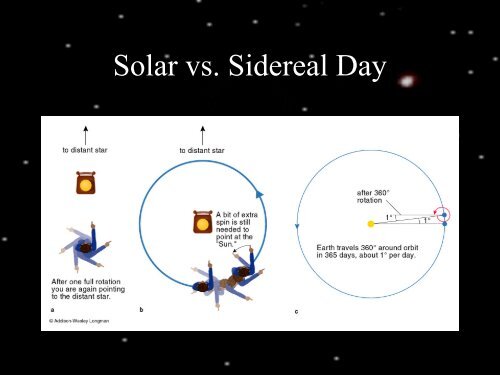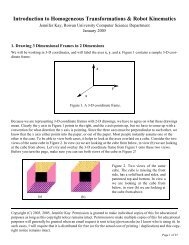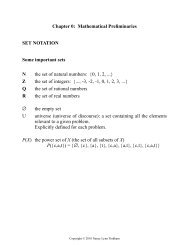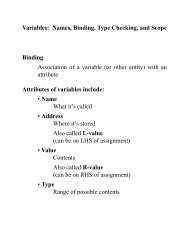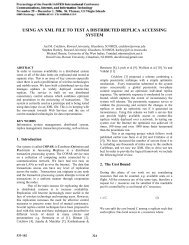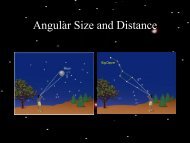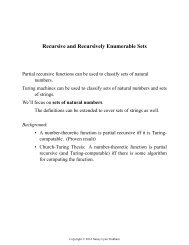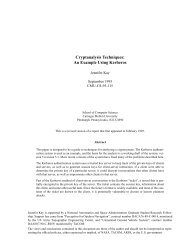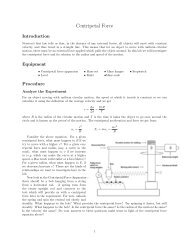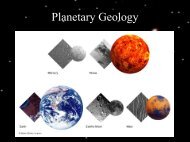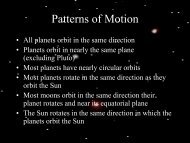Solar vs. Sidereal Day
Solar vs. Sidereal Day
Solar vs. Sidereal Day
You also want an ePaper? Increase the reach of your titles
YUMPU automatically turns print PDFs into web optimized ePapers that Google loves.
<strong>Solar</strong> <strong>vs</strong>. <strong>Sidereal</strong> <strong>Day</strong>
An Earth <strong>Day</strong><br />
• <strong>Sidereal</strong> <strong>Day</strong>: 23 hr 56 min 4 sec<br />
Motion relative to background stars<br />
• Mean <strong>Solar</strong> <strong>Day</strong>: 24 hours<br />
The average time between meridian<br />
crossings of the Sun<br />
• Apparent <strong>Solar</strong> <strong>Day</strong>: varies<br />
The actual time between the meridian<br />
crossings
Synodic <strong>vs</strong>. <strong>Sidereal</strong> Month
Lunar Month<br />
• <strong>Sidereal</strong> month: 27.321662 days. Defined<br />
relative to the stars.<br />
• Tropical month: 27.321582 days. Defined<br />
relative to the celestial equator.<br />
• Anomalistic month: 27.554550 days.<br />
Defined as perigee to perigee.
An Earth Year<br />
• Based on the motion of the Sun on the sky<br />
or the motion of Earth around the Sun<br />
• Julian Year: 365.25 mean solar days.<br />
Used in calendars before 1582.<br />
• Gregorian Year: 365.2425 mean solar days.<br />
Used in calendars today.
An Earth Year<br />
•<strong>Sidereal</strong> Year: 365.256363 mean solar days.<br />
Defined by the motion relative to stars.<br />
• Anomalistic Year: 365.259635 mean solar<br />
days. Defined as perihelion to perihelion.<br />
• Tropical year: 365.242190 mean solar days.<br />
Defined from equinox to equinox. Thus,<br />
related to the seasons.
Definitions<br />
• Zenith: The point on the sky that is directly<br />
overhead of the observer.<br />
• Horizon: The great circle on the celestial<br />
sphere that is 90 degrees from the zenith<br />
• Hour circle: The great circle through the<br />
position of a celestial body and the celestial<br />
poles<br />
• Meridian: The great circle passes through<br />
the zenith and both celestial poles
Even more definitions<br />
• Altitude: The minimum angular distance between<br />
the position of a celestial body and the horizon<br />
• Azimuth: The angular bearing of an object,<br />
measured from North (0 degrees) through East (90<br />
degrees), South (180 degrees), West (270<br />
degrees), and back to North (360 degrees)<br />
• Hour angle: The angle between the meridian and<br />
an object’s hour circle (west is positive)
Even more definitions<br />
• Declination: The minimum angular<br />
distance from the position of a celestial<br />
body and the celestial equator<br />
• Right Ascension: The eastward angle from<br />
the vernal equinox to the intersection of an<br />
object’s hour circle with the equator<br />
• An hour of angle = 15 degrees
Motion on the Sky
Time Zones
Motion Depends on Declination
The Sky at the North Pole<br />
• At the North Pole, the<br />
North Celestial Pole is<br />
at the zenith<br />
• Stars never rise or set<br />
• Planets, Moon, and<br />
Sun do rise and<br />
set…Why?
Stars Rise and Set at the Equator
The Sky at Our Latitude
The Sky at Southern Latitudes
Sun Changes Declination
The Arctic and Tropical Regions<br />
• How are the arctic and<br />
tropical regions<br />
defined?<br />
• Can you answer this<br />
without looking at<br />
your books?<br />
• Have you ever been to<br />
these regions?
Back to the North Pole
Back to the Equator
Cold Arctic Regions
Tropical Heat<br />
• In the Tropics, Sun is<br />
always close to zenith<br />
• In the Tropics, the sun<br />
reaches the Zenith at<br />
some point in the year<br />
• Lots of heating due to<br />
sunlight
Land of the Midnight Sun
The Sky for Navigation


